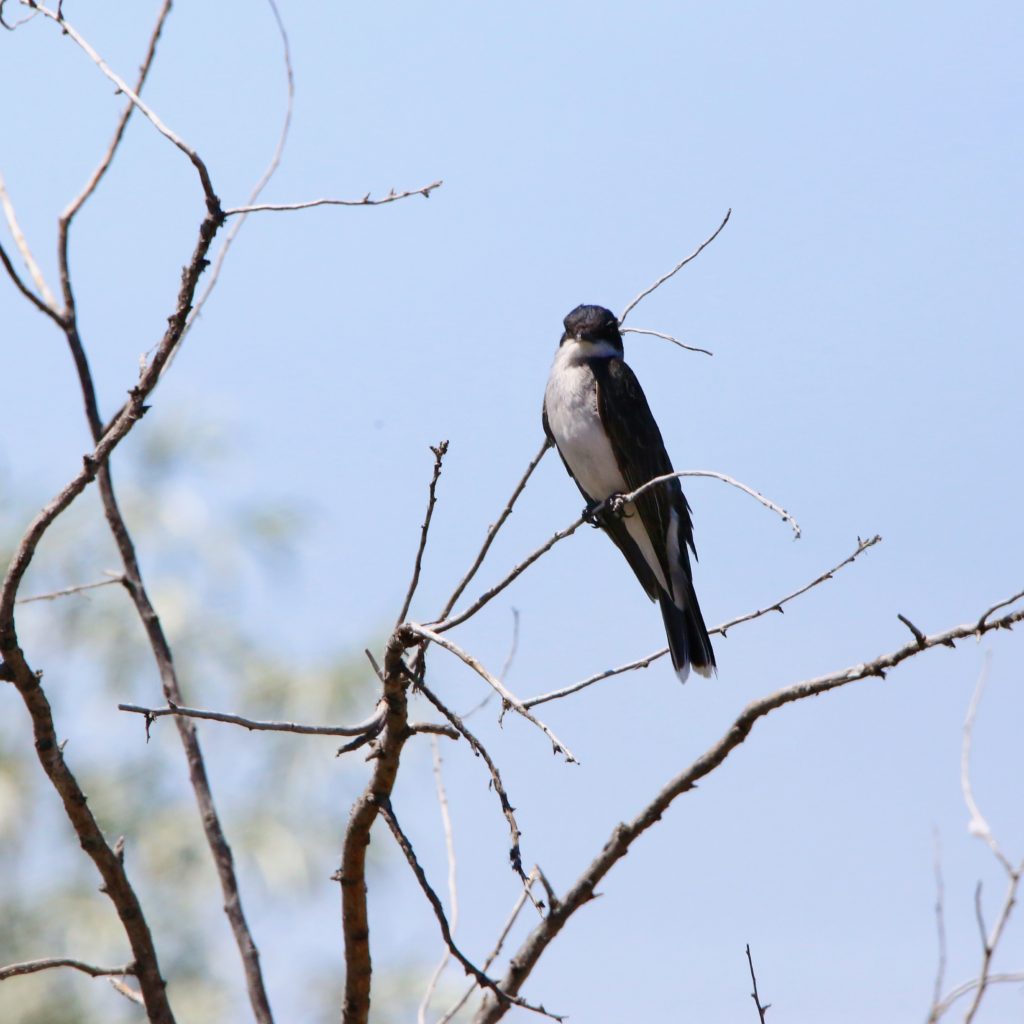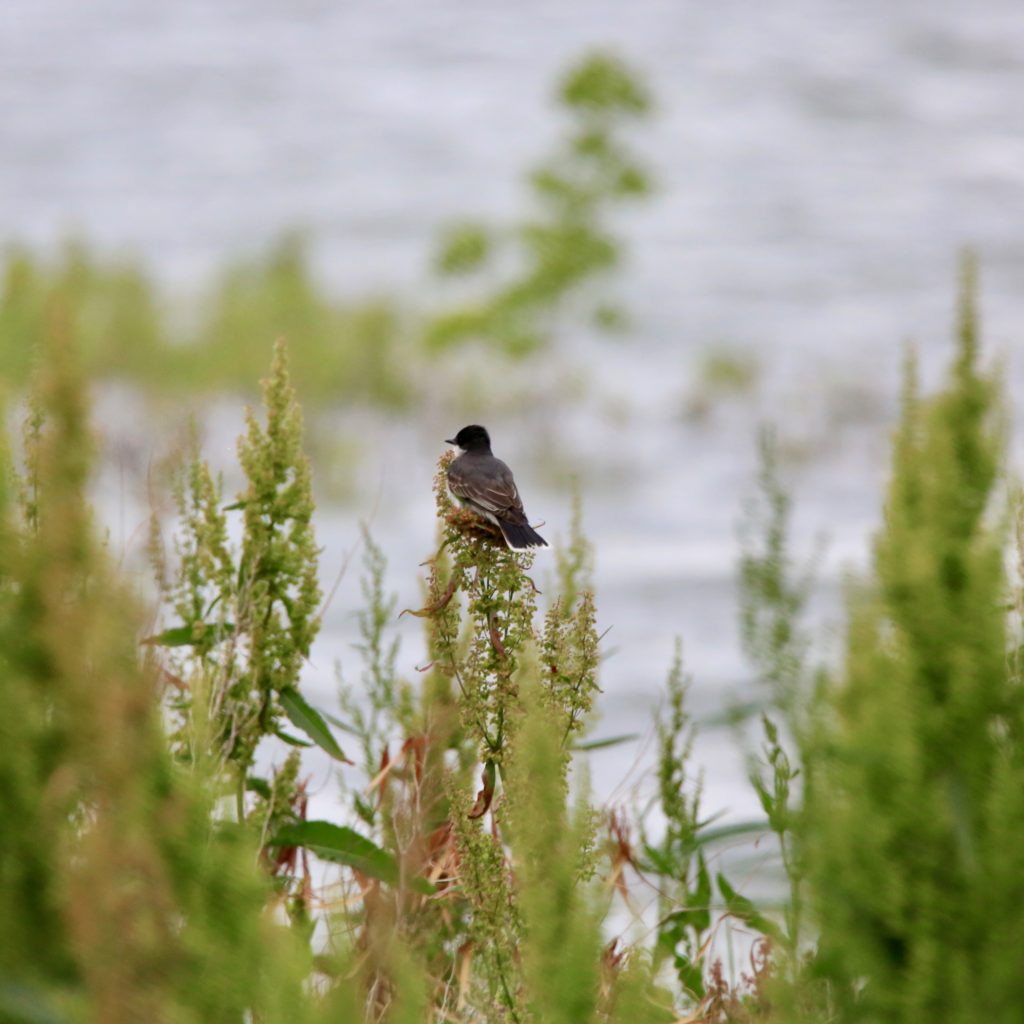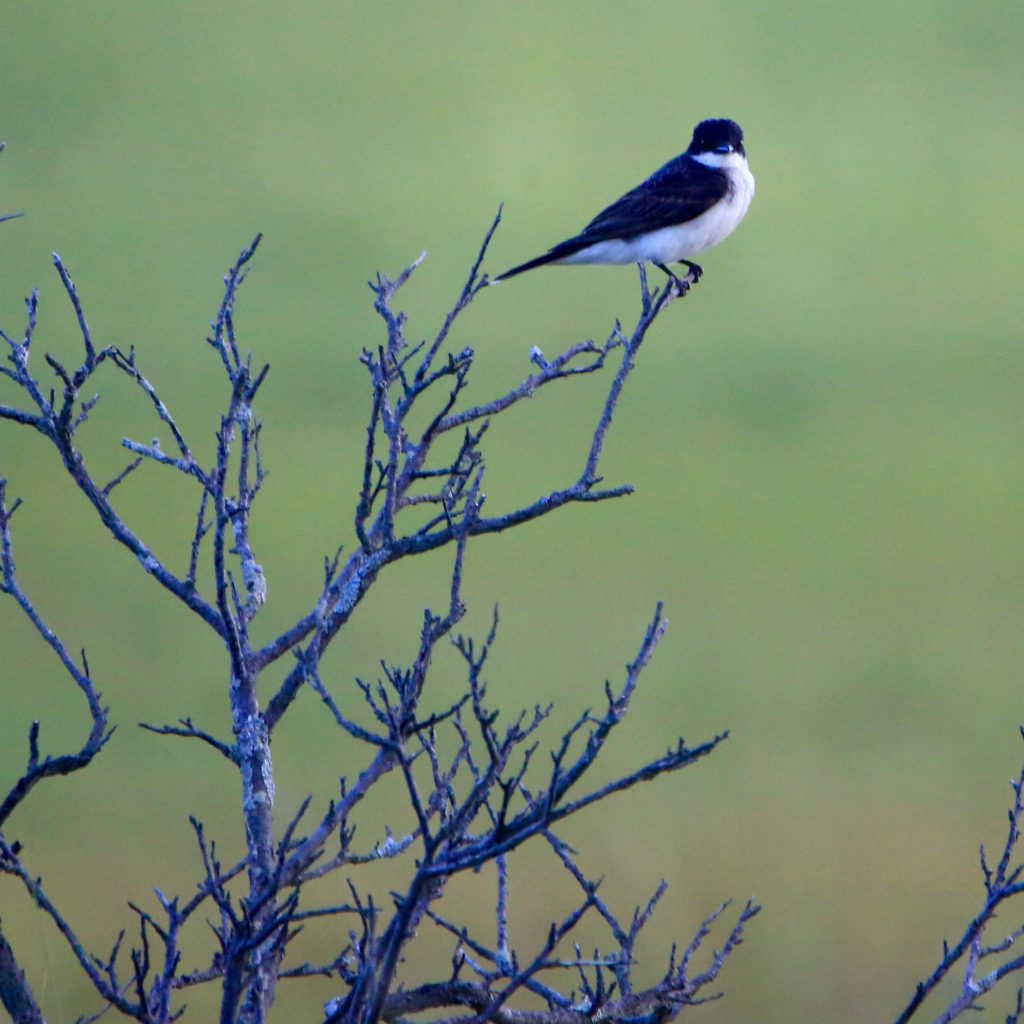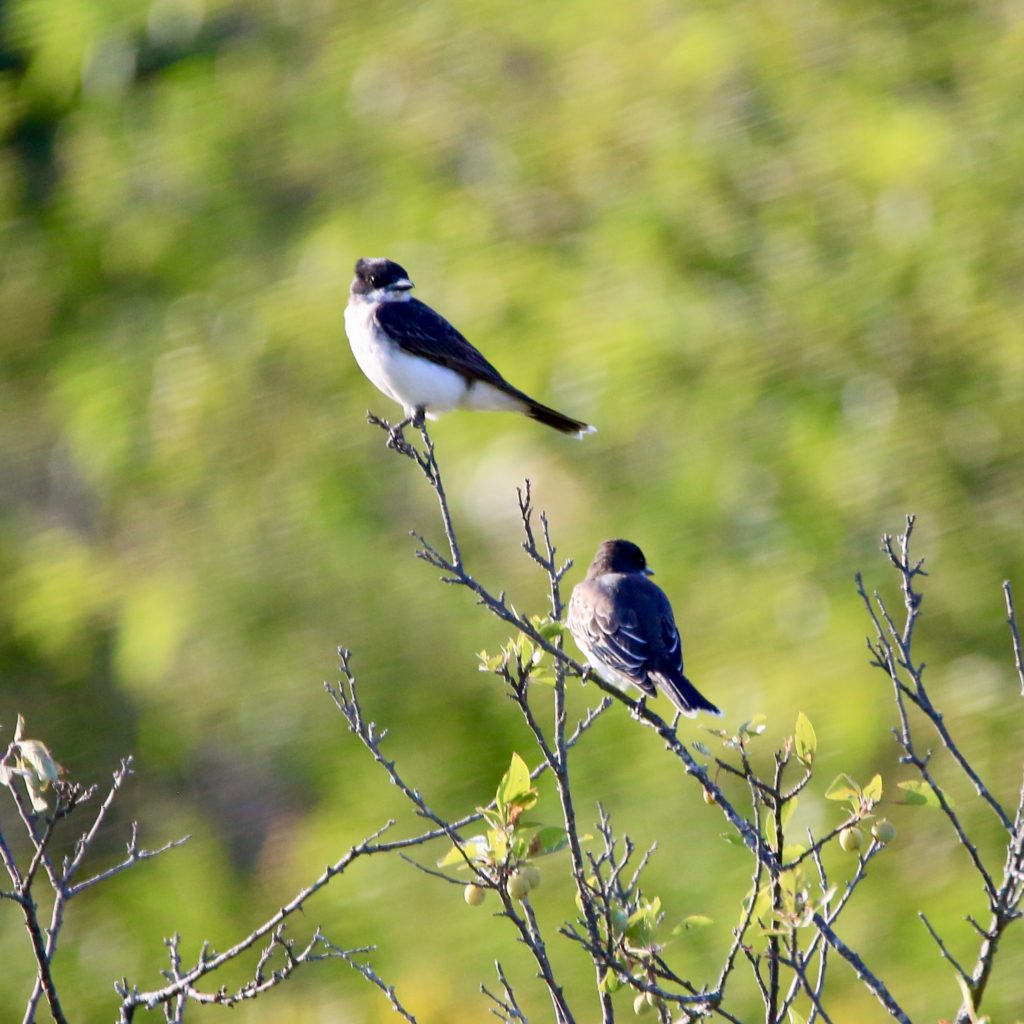The Eastern Kingbird
An Eastern Kingbird is a fun bird to see while bird watching. Below are some tips to help you identify Eastern Kingbirds. We have also put together a list of fun Eastern Kingbird t-shirts, Eastern Kingbird bird patches, bird houses, bird feeders, binoculars, stickers and other fun bird watching items.
About Eastern Kingbirds
The Eastern Kingbird is a large tyrant flycatcher found in North America. It belongs to the same family as the Western Kingbird and takes on the same aggressive character. It harasses other types of birds including the larger crow. While bird watching, a quick glance at it makes it seem like the bird is wearing a business suit. There is a gradual decrease in numbers since the 1960s but they are still widespread and common in eastern regions of North America.
Description and Identification
Eastern Kingbirds are relatively large birds but average in size for kingbirds. They are 7.5-9.1
inches long, and have a wingspan of 13-15 inches. Eastern Kingbirds look unlike other kingbirds
because their bright crown is concealed under their gray head. This crown of red, yellow, or orange
feathers can possibly be noticed when it encounters a potential predator. These birds generally
reveal their bright crown patches while attacking predators with their beaks. Under non-threatening
circumstances, these birds look like they are wearing a business suit. Eastern Kingbirds have dark
gray upperparts with light gray underparts. Their wings are pointed, and they have a long black tail
with a neat white tip at the end.
Eastern Kingbird Color Pattern
The bird has a dark-gray upper body and a neat white tip to the tail. The underparts are also white with whitish edges on the wing feathers.
Eastern Kingbird Size
The bird is big-headed and broad-shouldered to help it wade off other birds that fly over its territory. They are of average size for a kingbird with their length measuring 19-23cm. Their wingspan ranges between 33-38cm while their body weight ranges between 33 and 55g.

Eastern Kingbird Behavior
The Eastern Kingbird breeds in North America during summer and migrates to South America during winter. They build their cup-shaped nests up on treetops or utility poles just like their western counterparts. They are generally aggressive birds as they can be seen fighting off larger birds from their territory. The bird can be easily sighted during bird watching when they are perched on utility lines alongside the road.
Eastern Kingbird Food
Eastern Kingbirds perch in fields, fenceposts, wires, or shrubs; waiting to catch and eat insects in
midair. During their breeding season and spring migration, they mainly feed on beetles, ants,
crickets, locusts, bugs, wasps, and flies. Eastern Kingbirds generally enjoy eating large insects
which they beat to submission before swallowing whole. They also catch insects from the surface
of water, or vegetation in close proximity to their nesting sites. These birds change their diet when
they migrate in the fall to a majorly fruit-based diet. They feast on fruits such as cherries,
blackberries, elderberries, and nightshade. Fruits are also their primary source of food on the
wintering grounds.
They mainly feed on insects like wasps, bees, beetles, winged ants, grasshoppers, flies, and leafhoppers among others. They also rely on fruits like wild berries and wild fruits. They rely on insects as their summer diet.
Eastern Kingbird Habitat
During breeding season Eastern Kingbirds can mainly be found in orchards, open fields, and along
forest edges across North America. They may also breed in parks, golf courses, city areas with tall
trees, desert coasts, and various open spaces. Eastern Kingbirds love water, usually preferring to
nest in trees that are situated above water bodies. Excepting northern Canada and southwestern
In the United States, these birds are so widespread that they can be found in all kinds of habitats in North
America. Their wintering grounds are usually in forests near rivers or lakes.
The Eastern Kingbird can be found in river groves, wood edges, farms, orchards, and roadsides. In summer, they require open spaces for hunting and catching insects and trees for nesting.
Range and Migration

Eastern Kingbirds are large flycatchers native to eastern North America. These birds are long-distance migrants that travel all the way from North America to South America for their wintering
grounds. Eastern Kingbirds usually travel in flocks. These birds, unlike many other migratory
songbirds, travel by day. Eastern Kingbirds are the only kingbirds commonly found in eastern North
American, hence earning their name.
Eastern Kingbird Life Cycle
The female can lay up to 5 eggs and take 16-18 days for incubation. Once they hatch, the young take another 16-18 days till they have their first flight and leave. A mature adult lives for about two and a half years before they die.
Eastern Kingbird Nesting
Eastern Kingbirds are non-monogamous birds. Some Eastern Kingbirds choose to hide their nests,
while others prefer keeping them in the open. Females build the nests over a couple of weeks
while the males closely monitor them, probably to warn them of predators, or to avoid them from
mating with other males. The nest is generally very sturdy, build to withstand the windy weather
that may accompany an open nest site. Both members of the pair participate in defending the nest
from predators, using their characteristic aggressive behavior to drive away birds larger than
them. After laying 2-5 eggs, they have an incubation period of 14-17 days.
Ornithology
Bird Watching Academy & Camp Subscription Boxes
At Bird Watching Academy & Camp we help kids, youth, and adults get excited and involved in bird watching. We have several monthly subscription boxes that you can subscribe to. Our monthly subscription boxes help kids, youth, and adults learn about birds, bird watching, and bird conservation.
Bird Watching Binoculars for Identifying Eastern Kingbirds
The most common types of bird watching binoculars for viewing Eastern Kingbirds are 8×21 binoculars and 10×42 binoculars. Bird Watching Academy & Camp sells really nice 8×21 binoculars and 10×42 binoculars. You can view and purchase them here.
Eastern Kingbird T-shirts
If you love the Eastern Kingbird you should purchase a Bird Watching Academy & Camp T-shirt. To help support bird conservation we donate 10 percent to bird conservation activities.
Eastern Kingbird Iron On Patches
Kids, Youth, and Adults love to collect our Bird Watching Academy & Camp iron-on patches. Our bird-watching patches help you keep track of the birds you have seen and identified. You can also display the patches on our Bird Watching Academy & Camp banners.
The Eastern Kingbird is a great iron-on patch to start your collection with. The patches are durable and can be sewn on or ironed on to just about anything.
Eastern Kingbird Stickers
Stickers are a great way for you to display your love for bird watching and the Eastern Kingbird. We sell a monthly subscription sticker pack. The sticker packs have 12 bird stickers. These sticker packs will help your kids learn new birds every month.
Bird Feeders For Eastern Kingbirds
There are many types of bird feeders. Here are our favorite bird feeders for your backyard. We use all of these bird feeders currently. Kids will have a great time watching birds eat at these bird feeders. Using this collection of bird feeders will provide a wide variety and many types of birds.
Best Bird Houses for Eastern Kingbirds
There are many types of birdhouses. Building a birdhouse is always fun but can be frustrating. These 4 birdhouses have become our favorites. Getting a birdhouse for kids to watch birds grow is always fun. We spent a little extra money on these birdhouses but they have been worth the higher price and look great.
























